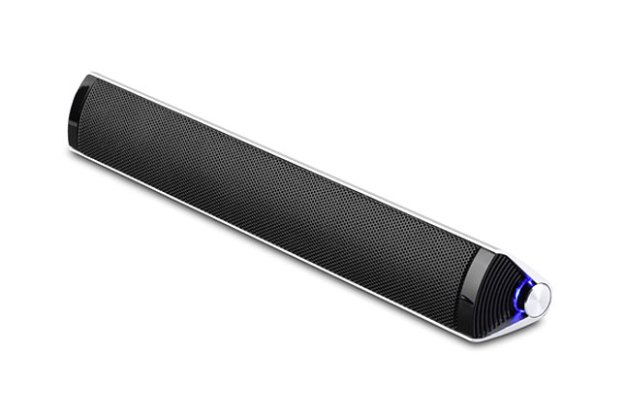
“Edifier's Sound To Go offers a relativity inexpensive solution for boosting your laptop's sound without sacrificing too much portability.”
- Impressive volume
- Excellent build quality
- Great sound quality overall
- Flexible for both laptops and MP3 players
- Awkward volume button
- No internal power
- Sound quality suffers a little at higher volumes

Features and design
The Sound To Go features two ports: a mini-USB port and a 3.5mm auxiliary input port. The USB connection provides both power and audio signal for simple plug-and-play setup with your computer, or you can connect another device, like an iPod, with the auxiliary input. The device features one button, located on one end of the system, used to control the volume.
Two 1-1/4-inch mid range drivers, two 1-1/4inch tweeters and a 3 x 1-1/4-inch oval subwoofer deliver the system’s sound. A built-in amplifier provides plenty of power to the speakers which pump out surprising volume. The system’s dimensions are roughly 10 -1/2-inchs wide, 1-1/2-inches high and 1-3/4-inches deep.

What’s in the box
In addition to the speaker system, Edifier includes a soft carrying case and USB cable.
 Setup and use
Setup and use
Using the soundbar is about as easy as it gets. Simply plug it into your computer’s USB port and it will automatically install the necessary drivers to get it up and running. A blue light next to the volume knob signals when the device is turned on. Your computer should automatically recognize it and select it as your default audio output device. Switching between the soundbar and the built-in laptop speakers was seamless for us. Remove the USB cable and your computer will revert back to its own speakers, plug it back in and it will output through the soundbar again.
Changing the volume may be the most frustrating aspect of the system. To raise the volume, you have to repeatedly push the button, to lower the volume you must hold down until it lowers to your desired level. It seems like an simple, elegant way to combine two buttons into one, but we thought it was a little unintuitive and difficult to use at times.
When using the 3.5mm input with an MP3 player or other external source, you must still have the device connected to USB for power, since there is no internal battery. This may seem like more of a hassle than it is, as almost any USB port will power the device. We tested it with an iPhone USB wall adapter, Xbox 360, and PS3 and had no issues.
 Performance
Performance
The sound quality pumped out by Edifier’s micro system is impressive. We can’t imagine even the best built-in laptop speakers outperforming it. At lower volumes, the highs and mids are clean and rich with satisfactory bass. As you pump the volume up, the sound starts to fall apart a bit, but the little speakers do an admirable job of keeping up. The system sounds best when kept below around the 70 percent volume level, offering rich bass. It won’t shake the table but, for something this size it’s about what you would expect. The diminutive device can easily fill a small room with sound. At highest volume, it’s is even a bit loud if it’s sitting right in front of you on your notebook. You won’t be able to use it for house parties, but for it should work great for listening to music and watching movies with a small group.
Conclusion
For $50, the Sound To Go offers a big step up in sound quality and volume over built-in speakers. The audio is crisp at lower volumes, and holds on pretty well as the volume increases. The design and build quality are excellent, with the volume button being our only minor gripe. We like the inclusion of an auxiliary input, which gives it the flexibility to work with MP3 players and sources, but we wish there were an option for internal power in case a USB jack is not available. Overall, the Sound To Go offers a relativity inexpensive solution for boosting your laptop’s sound without sacrificing too much portability.
Highs:
- Impressive volume
- Excellent build quality
- Great sound quality overall
- Flexible for both laptops and MP3 players
Lows:
- Awkward volume button
- No internal power
- Sound quality suffers a little at higher volumes






